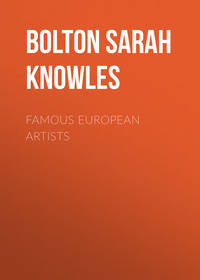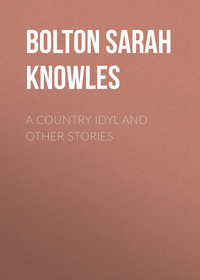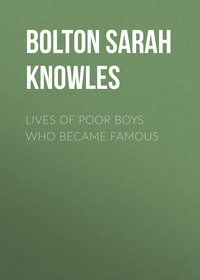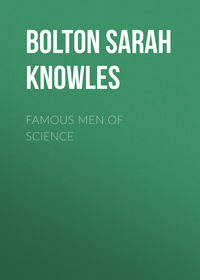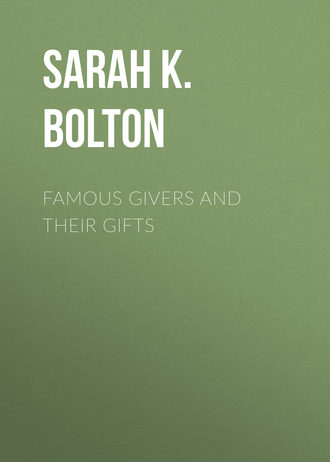 полная версия
полная версияFamous Givers and Their Gifts
Mr. Rockefeller's private charities have been almost numberless. He has aided young men and women through college, sometimes by gift and sometimes by loan. He has provided the means for persons who were ill to go abroad or elsewhere for rest. He does not forget, when his apples are gathered at Pocantico Hills, to send hundreds of barrels to the various charitable institutions in and near New York, or, when one of his workingmen dies, to continue the support to his family while it is needed. Some of us become too busy to think of the little ways of doing good. It is said by those who know him best, that he gives more time to his benevolences and to their consideration than to his business affairs. He employs secretaries, whose time is given to the investigation of requests for aid, and attending to such cases as are favorably decided upon.
Mr. Rockefeller's usual plan of giving is to pledge a certain sum on condition that others give, thus making them share in the blessings of benevolence. At one time he gave conditionally about $300,000, and it resulted in $1,700,000 being secured for some twenty or thirty institutions of learning in all parts of the country. It is said by a friend, that on his pledge-book are hundreds of charities to which he gives regularly many thousand dollars each month.
His greatest gift has been that of $7,425,000 to the University of Chicago. The first University of Chicago existed from 1858 to 1886, a period of twenty-eight years, and was discontinued from lack of funds. When the American Baptist Education Society, formed at Washington, D.C., in May, 1888, held its first anniversary in Tremont Temple, Boston, it was resolved "to take immediate steps toward the founding of a well-equipped college in the city of Chicago." Mr. Rockefeller had already become interested in founding such an institution, and made a subscription of $600,000 toward an endowment fund, conditioned on the pledging by others of $400,000 before June 1, 1890. The Rev. T. W. Goodspeed, and the Rev. E. T. Gates, Secretary of the Education Society, succeeded in raising this amount, and in addition a block and a half of ground as a site for the institution, valued at $125,000, given by Mr. Marshall Field of Chicago. Two and a half blocks were purchased for $282,500, making in all twenty-four acres, lying between the two great south parks of Chicago, Washington and Jackson, and fronting on the Midway Plaisance, a park connecting the other two. These parks contain a thousand acres.
The university was incorporated in 1890, and Professor William Rainey Harper of Yale University was elected President. The choice was an eminently wise one, a man of progressive ideas being needed for the great university. He had graduated at Muskingum College in 1870, taken his degree of Ph.D. at Yale in 1875, been Professor of Hebrew and the cognate languages at the Baptist Union Theological Seminary for seven years, Professor of the Semitic Languages at Yale for five years, and Woolsey Professor of Biblical Literature at Yale for two years, besides filling other positions of influence.
In September, 1890, Mr. Rockefeller made a second subscription of $1,000,000; and, in accordance with the terms of this gift, the Theological Seminary was removed from Morgan Park to the University site, as the Divinity School of the University, and dormitories erected, and an academy of the University established at Morgan Park.
The University began the erection of its first buildings Nov. 26, 1891. Mr. Henry Ives Cobb was chosen as the architect, and the English Gothic style is to be maintained throughout. The buildings are of blue Bedford stone, with red tiled roofs. The recitation buildings, laboratories, chapel, museum, gymnasium, and library are the central features; while the dormitories are arranged in quadrangles on the four corners.
Mr. Rockefeller's third gift was made in February, 1892, "one thousand five per cent bonds of the par value of one million dollars," for the further endowment of instruction. In December of the same year he gave an equal amount for endowment, "one thousand thousand-dollar five per cent bonds." In June, 1893 he gave $150,000; the next year, December, 1894, in cash, $675,000. On Jan. 1, 1896, another million, promising two millions more on condition that the University should also raise two millions. Half of this sum was obtained at once through the gift of Miss Helen Culver. In her letter to the trustees of the University, she says, "The whole gift shall be devoted to the increase and spread of knowledge within the field of biological science… Among the motives prompting this gift is the desire to carry out the ideas, and to honor the memory, of Mr. Charles J. Hull, who was for a considerable time a member of the Board of Trustees of the old University of Chicago."
Miss Culver is a cousin of the late Mr. Hull, who left her his millions for philanthropic purposes. Their home for many years was the mansion since known as Hull House.
The University of Chicago has been fortunate in other gifts. Mr. S. A. Kent of Chicago gave the Kent Chemical Laboratory, costing $235,000, opened Jan. 1, 1894. The Ryerson Physical Laboratory, costing $225,000, opened July 2, 1894, was the gift of Mr. Martin A. Ryerson, as a memorial to his father. Mrs. Caroline Haskell gave $100,000 for the Haskell Oriental Museum, as a memorial of her husband, Mr. Frederick Haskell. There will be rooms for Egyptian, Babylonian, Greek, Hebrew, and other collections. Mr. George C. Walker, $130,000 for the Walker Museum for geological and anthropological specimens; Mr. Charles T. Yerkes, nearly a half million for the Yerkes Observatory and forty-inch telescope; Mrs. N. S. Foster, Mrs. Henrietta Snell, Mrs. Mary Beecher, and Mrs. Elizabeth G. Kelley have each given $50,000, or more, for dormitories. It is expected that half a million will be realized from the estate of William B. Ogden for "The Ogden (graduate) School of Science." The first payment has amounted to half that sum. Considerably over $10,000,000 have been given to the University. The total endowment is over $6,000,000.
The University opened its doors to students on Oct. 1, 1892, in Cobb Lecture Hall, given by Mr. Silas B. Cobb of Chicago, and costing $150,000. The number of students during the first year exceeded nine hundred. The professors have been chosen with great care, and number among them some very distinguished men, from both the Old World and the New. The University of Chicago is co-educational, which is matter for congratulation. Its courses are open on equal terms to men and women, with the same teachers, the same studies, and the same diplomas. "Three of the deans are women," says Grace Gilruth Rigby in Peterson's Magazine for February, 1896, "and half a dozen women are members of its faculty. They instruct men as well as women, and in this particular it differs from most co-educational schools."
The University has some unique features. Instead of the usual college year beginning in September, the year is divided into four quarters, beginning respectively on the first day of July, October, January, and April, and continuing twelve weeks each, with a recess of one week between the close of each quarter and the beginning of the next. Degrees are conferred the last week of every quarter. The summer quarter, which was at first an experiment, has proved so successful that it is now an established feature.
The instructor takes his vacation in any quarter, or may take two vacations of six weeks each. The student may absent himself for a term or more, and take up the work where he left off, or he may attend all the quarters, and thus shorten his college course. Much attention is given to University Extension work, and proper preparatory work is obtained through the affiliation of academies with the University. Instruction is also given by the University through correspondence with those who wish to pursue preparatory or college studies.
"Chicago is, as far as I am aware," writes the late Hjalmar Hjorth Boyesen in the Cosmopolitan for April, 1893, "the first institution which, by the appointment of a permanent salaried university extension faculty, has formally charged itself with a responsibility for the outside public. This is a great step, and one of tremendous consequence."
A non-resident student is expected to matriculate at the University, and usually spends the first year in residence. Non-resident work is accepted for only one-third of the work required for a degree.
The University has eighty regular fellowships and scholarships, besides several special fellowships.
The institution, according to Robert Herrick, in Scribner's Magazine for October, 1895, seems to have the spirit of its founder. "Two college settlements in the hard districts of Chicago," he writes, "are supported and manned by the students… The classes and clubs of the settlements show that the college students feel the impossibility of an academic life that lives solely to itself. On the philanthropic committee, and as teachers in the settlement classes, men and women, instructors and students, work side by side. The interest in sociological studies, which is commoner at Chicago than elsewhere, stimulates this modern activity in college life."
The University of Chicago has been successful from the first. In 1895 it numbered 1,265 students, of whom 493 were in the graduate schools, most of them having already received their bachelor's degree at other colleges. In 1896 there are over 1,900 students. The possibilities of the university are almost unlimited.
Dr. Albert Shaw writes in the Review of Reviews for February, 1893, "No rich man's recognition of his opportunity to serve society in his own lifetime has ever produced results so mature and so extensive in so very short a time as Mr. John D. Rockefeller's recent gifts to the Chicago University."
The New York Sun for July 4, 1896, gives Mr. Rockefeller the following well-deserved praise: "Mr. John D. Rockefeller has paid his first visit to the University of Chicago, which was built up and endowed by his magnificent gifts. The millions he has bestowed on that institution make him one of the very greatest of private contributors to the foundation of a school of learning in the whole history of the world. He has given the money, moreover, in his lifetime, and thus differs from nearly all others of the most notable founders and endowers of colleges.
"By so giving, too, he has distinguished himself from the great mass of all those who have made large benefactions for public uses. He has taken the millions from his rapidly accumulating fortune; and he has made the gifts quietly, modestly, and without the least seeking for popular applause, or to win the conspicuous manifestations of honor their munificence could easily have obtained for him. The reason for this remarkable peculiarity of Mr. Rockefeller as a public benefactor is that, being a deeply religious man, he has made his gifts as an obligation of religious duty, as it seems to him."
Mr. Rockefeller's latest gift, of $600,000, was made to the people of Cleveland, Ohio, when that city celebrated her one hundredth birthday, July 22, 1896. The gift was two hundred and seventy-six acres of land of great natural beauty, to complete the park system of the city. For this land Mr. Rockefeller paid $600,000. The land is already worth a million dollars, and will be worth many times that amount in the years to come.
When announcing Mr. Rockefeller's munificent gift to the city, Mr. J. G. W. Cowles, president of the Chamber of Commerce, said of the giver: "His modesty is equal to his liberality, and he is not here to share with us this celebration. The streams of his benevolence flow largely in hidden channels, unseen and unknown to men; but when he founds a university in Chicago, or gives a beautiful park to Cleveland, with native forests and shady groves, rocky ravines, sloping hillsides and level valleys, cascades and running brook and still pools of water, all close by our homes, open and easy of access to all our people, such deeds cannot be hid – they belong to the public and to history, as the gift itself is for the people and for posterity."
The Centennial gift has caused great rejoicing and gratitude, and will be a blessing forever to the whole people, but especially to those whose daily work keeps them away from the fresh air and the sunshine.
A day or two after the gift had been received, a large number of Cleveland's prominent citizens visited the giver at his home at Forest Hill, to express to him the thanks of the city. After the address of gratitude, Mr. Rockefeller responded with much feeling.
"This is our Centennial year," he said. "The city of Cleveland has grown to great proportions, and has prospered far beyond anything any of us had anticipated. What will be said by those who will come after us when a hundred years hence this city celebrates its second Centennial anniversary, and reference is made to you, gentlemen, and to me? Will it be said that this or that man has accumulated great treasures? No; all that will be forgotten. The question will be, What did we do with our treasures? Did we, or did we not, use them to help our fellow-man? This will be forever remembered."
After referring to his early school-life in the city, and efforts to find employment, he told how, needing a little money to engage in business, and in the "innocence of his youth and inexperience" supposing almost any of his business friends would indorse his note for the amount needed, he visited one after another; and, said Mr. Rockefeller, "each one of them had the most excellent reasons for refusing!"
Finally he determined to try the bankers, and called upon a man whom the city delights to honor, Mr. T. P. Handy. The banker received the young man kindly, invited him to be seated, asked a few questions, and then loaned him $2,000, "a large amount for me to have all at one time," said Mr. Rockefeller.
Mr. Rockefeller is still in middle life, with, it is hoped, many years before him in which to carry out his great projects of benevolence. He is as modest and gentle in manner, as unostentatious and as kind in heart, as when he had no millions to give away. He is never harsh, seems to have complete self-control, and has not forgotten to be grateful to the men who befriended and trusted him in his early business life.
His success may be attributed in part to industry, energy, economy, and good sense. He loved his work, and had the courage to battle with difficulties. He had steadiness of character, the ability to command the confidence of business men from the beginning, and gave close and careful attention to the matters intrusted to him.
Mr. Rockefeller will be remembered, not so much because he accumulated millions, but because he gave away millions, thereby doing great good, and setting a noble example.




